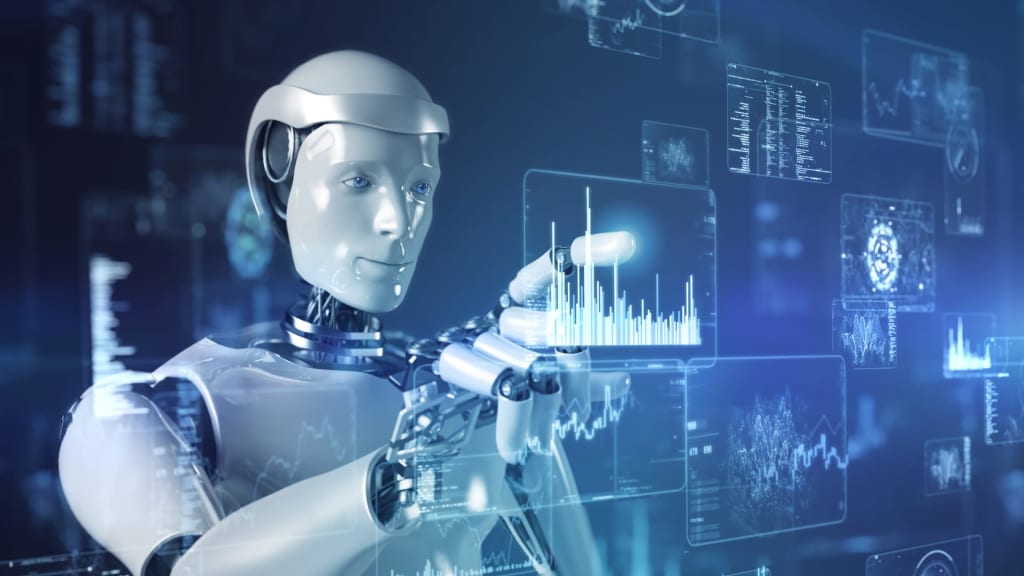EVOLUTION OF ARTIFICIAL INTELLIGENCE
Milestones from 1950 to 2023

Certainly, here's a more detailed AI timeline from 1950 to 2023:
1950:
Alan Turing introduces the "Turing Test" as a way to measure a machine's ability to exhibit intelligent behavior indistinguishable from that of a human.
1951:
Christopher Strachey develops the Ferranti Mark I Autocode, one of the earliest high-level programming languages designed for scientific and engineering computations.
1955:
Allen Newell and Herbert A. Simon develop the Logic Theorist, a computer program capable of proving mathematical theorems.
1956:
The term "Artificial Intelligence" is coined at the Dartmouth Workshop by John McCarthy and others, marking the birth of the AI field.
IBM introduces the IBM 704 computer, one of the first machines to be used in AI research.
1958:
John McCarthy invents the Lisp programming language, which becomes a significant tool for AI research.
1960:
John McCarthy creates the "Advice Taker," an early concept of a self-improving AI system.
Isaac Asimov's "I, Robot" introduces the "Three Laws of Robotics," influencing discussions about AI ethics.
1961:
James Slagle develops SAINT, an early computer program that could solve calculus problems symbolically.
1963:
John McCarthy proposes the idea of time-sharing, which later becomes essential for multi-user access to computers.
1966:
ELIZA, an early natural language processing computer program, is created by Joseph Weizenbaum, simulating conversation using pattern matching techniques.
1969:
The Stanford Cart, developed by Hans Moravec, becomes one of the first robots to move autonomously.
1970:
Marvin Minsky and Seymour Papert publish "Perceptrons," a book that critically analyzes the limitations of single-layer neural networks.
1973:
The PROLOG programming language, designed for automated reasoning and problem solving, is developed by Alain Colmerauer and Philippe Roussel.
1974:
The MYCIN system, an early expert system for diagnosing bacterial infections, is developed at Stanford University.
1980:
The first commercial expert system, R1/XCON, is developed by Digital Equipment Corporation for configuring computer systems.
1981:
Richard Karp proves the NP-completeness of various combinatorial problems, leading to advancements in understanding computational complexity.
1985:
The first successful application of backpropagation algorithm for training neural networks is demonstrated by Robert Hecht-Nielsen.
1987:
The concept of recurrent neural networks (RNNs) is introduced, paving the way for modeling sequences and time-series data.
1988:
The "neocognitron," a hierarchical artificial neural network, is proposed by Kunihiko Fukushima, serving as an early model for deep learning.
1990:
The World Chess Championship is won by Deep Thought, an AI chess computer developed by IBM.
1997:
IBM's Deep Blue defeats world chess champion Garry Kasparov in a series of matches, showcasing the power of computer algorithms in strategic games.
1998:
The European RoboCup initiative begins, promoting robotics and AI research through soccer-playing autonomous robots.
2000:
The first DARPA Grand Challenge is held, encouraging advancements in autonomous vehicle technology.
2005:
Ray Kurzweil publishes "The Singularity Is Near," discussing the potential of AI and technology to radically change humanity's future.
2011:
IBM's Watson defeats human champions in the quiz show "Jeopardy!", demonstrating AI's ability to process natural language and answer complex questions.
2012:
The ImageNet Large Scale Visual Recognition Challenge boosts the development of deep learning algorithms for image classification.
2014:
DeepMind's AI system learns to play video games in a manner similar to humans, showing the potential of deep reinforcement learning.
2016:
AlphaGo, an AI developed by DeepMind, defeats world champion Go player Lee Sedol, showcasing AI's capabilities in complex decision-making.
2018:
OpenAI introduces OpenAI Five, an AI system capable of playing the video game Dota 2 at a high level.
2020:
OpenAI releases GPT-3, a highly advanced language model, sparking discussions about AI's potential and ethical implications.
2021:
AI-driven medical advancements accelerate, including AI models for diagnosing diseases from medical images.
2022:
Ethical considerations around AI, including bias and transparency, gain prominence in discussions among researchers, policymakers, and the public.
2023:
AI continues to influence various aspects of society, including healthcare, finance, and entertainment.
Research and development in AI ethics, explainability, and fairness remain at the forefront of the field.
About the Creator
Alishba Humair
Passionate storyteller and wordsmith, I am on a journey to captivate hearts and minds through the power of words.My goal is to inspire, educate, and spark meaningful conversations that make a positive impact on the world.






Comments
There are no comments for this story
Be the first to respond and start the conversation.